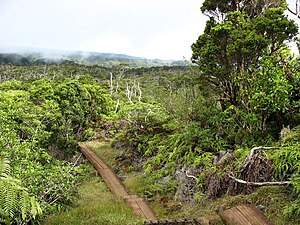The Hawaiian tropical rainforests are a tropical moist broadleaf forest ecoregion in the Hawaiian Islands. They cover an area of 6,700 km2 (2,600 sq mi) in the windward lowlands and montane regions of the islands.[1] Coastal mesic forests are found at elevations from sea level to 300 m (980 ft).[2] Mixed mesic forests occur at elevations of 750 to 1,250 m (2,460 to 4,100 ft), while wet forests are found from 1,250 to 1,700 m (4,100 to 5,580 ft). Moist bogs and shrublands exist on montane plateaus and depressions.[1] For the 28 million years of existence of the Hawaiian Islands, they have been isolated from the rest of the world by vast stretches of the Pacific Ocean, and this isolation has resulted in the evolution of an incredible diversity of endemic species, including fungi, mosses, snails, birds, and other wildlife. In the lush, moist forests high in the mountains, trees are draped with vines, orchids, ferns, and mosses.[3] This ecoregion includes one of the world's wettest places, the slopes of Mount Waiʻaleʻale, which average 373 in (9,500 mm) of rainfall per year.[4] 20°N 157°W / 20°N 157°W
| Hawaiian tropical rainforests | |
|---|---|
 | |
| Ecology | |
| Realm | Oceanian |
| Biome | Tropical and subtropical moist broadleaf forests |
| Borders | |
| Geography | |
| Area | 6,700 km2 (2,600 sq mi) |
| Country | United States |
| State | Hawaii |
| Climate type | Tropical rainforest (Af) |
| Conservation | |
| Conservation status | Critical/Endangered[1] |
| Global 200 | Yes[5] |
- ^ a b c "Hawaii tropical moist forests". Terrestrial Ecoregions. World Wildlife Fund. Retrieved 2011-11-19.
- ^ Kay, E. Alison (1995). A Natural History of the Hawaiian Islands: Selected Readings II. University of Hawaii Press. p. 147. ISBN 978-0-8248-1659-9.
- ^ World Wildlife Fund, ed. (2001). "Hawaii tropical moist forests". WildWorld Ecoregion Profile. National Geographic Society. Archived from the original on 2010-03-08. Retrieved 2009-02-19.
- ^ "MT WAIALEALE 1047, HAWAII (516565)". WRCC. NOAA. 1 August 2008. Retrieved 30 August 2018.
- ^ Olson, David M.; Eric Dinerstein (2002). "The Global 200: Priority Ecoregions for Global Conservation" (PDF). Annals of the Missouri Botanical Garden. 89 (2): 199–224. doi:10.2307/3298564. JSTOR 3298564.